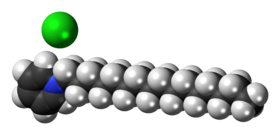
| |

| |
| Names | |
|---|---|
| Preferred IUPAC name
1-Hexadecylpyridin-1-ium chloride | |
| Other names
Acetoquat CPC;
Pyrisept EXADECYL-PYRIDINIUM, CHLORIDE | |
| Identifiers | |
3D model (JSmol)
|
|
| 3578606 | |
| ChEBI | |
| ChEMBL | |
| ChemSpider | |
| ECHA InfoCard | 100.004.177 |
PubChem CID
|
|
| UNII |
|
CompTox Dashboard (EPA)
|
|
| |
| |
| Properties | |
| C21H38ClN | |
| Molar mass | 339.99 g·mol−1 |
| Appearance | Solid |
| Melting point | 77 °C (171 °F; 350 K) |
| Pharmacology | |
| B05CA01 (WHO) | |
| Hazards | |
| Lethal dose or concentration (LD, LC): | |
LD50 (median dose)
|
36 mg/kg (rabbit, iv)[1] 400 mg/kg (rabbit, oral)[1] 6 mg/kg (rat, ip)[1] 30 mg/kg (rat, iv)[1] 200 mg/kg (rat, oral)[1] 250 mg/kg (rat, sc)[1] 10 mg/kg (mouse, ip)[1] 108 mg/kg (mouse, oral)[1] |
Except where otherwise noted, data are given for materials in their standard state (at 25 °C [77 °F], 100 kPa).
| |
Cetylpyridinium chloride (CPC) is a cationic quaternary ammonium compound used in some types of mouthwashes, toothpastes, lozenges, throat sprays, breath sprays, and nasal sprays. It is an antiseptic that kills bacteria and other microorganisms. It has been shown to be effective in preventing dental plaque and reducing gingivitis.[2][3] It has also been used as an ingredient in certain pesticides. As of the time of this update, one study[4] suggests cetylpyridinium chloride does not cause brown tooth stains, although particular questions regarding usage habits in patient context are best addressed by a dental office as opposed to legal marketing.[5] There are brands containing CPC as an active ingredient that may bear the warning label "In some cases, antimicrobial rinses may cause surface staining to teeth,"[6] following a failed class-action lawsuit brought by customers whose teeth were stained.[7]
The name breaks down as:
- cetyl- refers to the cetyl group, named for its relation to cetyl alcohol, which was first isolated from whale oil (Latin: cetus);[8]
- pyridinium refers to the cation [C5H5NH]+, the conjugate acid of pyridine;
- chloride refers to the anion Cl−.
- ^ a b c d e f g h Lewis, Richard J. (1996). Sax's Dangerous Properties of Industrial Materials (9th ed.). New York, NY: Van Nostrand Reinhold. p. 691.
- ^ Asadoorian, Joanna; Williams, Karen (2008). "Cetylpyridinium chloride mouth rinse on gingivitis and plaque". Journal of Dental Hygiene. 82 (5).
- ^ Haps, S.; Slot, D. E.; Berchier, C. E.; Van Der Weijden, G. A. (2008). "The effect of cetylpyridinium chloride-containing mouth rinses as adjuncts to toothbrushing on plaque and parameters of gingival inflammation: A systematic review". International Journal of Dental Hygiene. 6 (4): 290–303. doi:10.1111/j.1601-5037.2008.00344.x. PMID 19138180.
- ^ Rahman, B.; Alkawas, S.; Al Zubaidi, E. A.; Adel, O. I.; Hawas, N. (2014). "Comparative antiplaque and antigingivitis effectiveness of tea tree oil mouthwash and a cetylpyridinium chloride mouthwash: A randomized controlled crossover study". Contemporary Clinical Dentistry. 5 (4): 466–470. doi:10.4103/0976-237X.142813. PMC 4229754. PMID 25395761.
- ^ Ganeles, Jeffrey. "4 questions for successful consultations, Patient Communication and Patient Financing". DentalEconomic.com. Endeavor Business Media. Retrieved 7 November 2024.
- ^ Wintonyk, Darcy; Steele, Lynda (October 12, 2012). "Consumers spitting mad after mouthwash turns teeth brown". CTV British Columbia. Archived from the original on 6 June 2016.
The product does have a small print warning on the back label that reads: "In some cases, antimicrobial rinses may cause surface staining to teeth," but consumers have complained the warning label is buried in the product information.
- ^ White, Ed (August 6, 2009). "Mich. lawyer sues, claims mouthwash stained teeth". Associated Press. Archived from the original on 6 August 2016.
Rossman's lawsuit seeks class-action status. It accuses P&G of violating the Michigan Consumer Protection Act by not putting a warning on the label.
- ^ Nordegren, Thomas (2002). The A-Z Encyclopedia of Alcohol and Drug Abuse. Universal Publishers. p. 165. ISBN 1-58112-404-X.